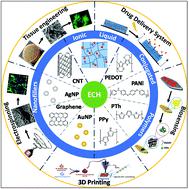当前位置:
X-MOL 学术
›
Biomater. Sci.
›
论文详情
Our official English website, www.x-mol.net, welcomes your
feedback! (Note: you will need to create a separate account there.)
Electro-responsive hydrogels: macromolecular and supramolecular approaches in the biomedical field
Biomaterials Science ( IF 5.8 ) Pub Date : 2020-09-18 , DOI: 10.1039/d0bm01268h Iga Carayon 1, 2, 3, 4, 5 , Alexandra Gaubert 1, 2, 3, 4, 5 , Yannick Mousli 1, 2, 3, 4, 5 , Barthélémy Philippe 1, 2, 3, 4, 5
Biomaterials Science ( IF 5.8 ) Pub Date : 2020-09-18 , DOI: 10.1039/d0bm01268h Iga Carayon 1, 2, 3, 4, 5 , Alexandra Gaubert 1, 2, 3, 4, 5 , Yannick Mousli 1, 2, 3, 4, 5 , Barthélémy Philippe 1, 2, 3, 4, 5
Affiliation

|
Hydrogels are soft materials of the utmost importance in the biomedical and healthcare fields. Two approaches can be considered to obtain such biomaterials: the macromolecular one and the supramolecular one. In the first, the chemical gel is based on crosslinking while in the second the physical hydrogel is stabilized thanks to noncovalent interactions. Recently, new trends rely on smart devices able to modify their physico-chemical properties under stimulation. Such stimuli-responsive systems can react to internal (i.e. pH, redox potential, enzyme, etc.) or external (i.e. magnetic field, light, electric field, etc.) triggers leading to smart drug release and drug delivery systems, 3D scaffolds or biosensors. Even if some stimuli-responsive biomaterials are currently widely studied, other ones represent a real challenge. Among them, electro-responsive hydrogels, especially obtained via supramolecular approach, are under-developped leaving room for improvement. Indeed, currently known macromolecular electro-responsive systems are reaching some limitations related to their chemical composition, physicochemical properties, mechanical strength, processing technologies, etc. In contrast, the interest for supramolecular hydrogels has risen for the past few years suggesting that they may provide new solutions as electro-responsive soft materials. In this short review, we give a recent non exhaustive survey on macromolecular and supramolecular approaches for electro-responsive hydrogels in the biomedical field.
中文翻译:

电响应水凝胶:生物医学领域的大分子和超分子方法
水凝胶是在生物医学和医疗保健领域最重要的软材料。可以考虑两种方法来获得这种生物材料:大分子材料和超分子材料。首先,化学凝胶是基于交联的,而第二,由于非共价相互作用,物理水凝胶是稳定的。最近,新趋势依赖于能够在刺激下改变其理化特性的智能设备。这种刺激响应系统可以向内部(反应即pH值,氧化还原电位,酶,等。)或外部(即磁场,光,电场,等。)触发因素导致智能药物释放和药物输送系统,3D支架或生物传感器。即使目前已经广泛研究了某些刺激响应性生物材料,其他材料还是一个真正的挑战。其中,特别是通过超分子方法获得的电响应水凝胶的开发不足,尚有待改进。实际上,当前已知的大分子电响应系统正达到与其化学组成,理化性质,机械强度,加工技术等有关的一些限制。。相反,在过去的几年中,人们对超分子水凝胶的兴趣不断上升,这表明它们可以提供新的解决方案作为电响应性软材料。在这篇简短的评论中,我们对生物医学领域中电响应水凝胶的大分子和超分子方法进行了近期非详尽的调查。
更新日期:2020-10-13
中文翻译:

电响应水凝胶:生物医学领域的大分子和超分子方法
水凝胶是在生物医学和医疗保健领域最重要的软材料。可以考虑两种方法来获得这种生物材料:大分子材料和超分子材料。首先,化学凝胶是基于交联的,而第二,由于非共价相互作用,物理水凝胶是稳定的。最近,新趋势依赖于能够在刺激下改变其理化特性的智能设备。这种刺激响应系统可以向内部(反应即pH值,氧化还原电位,酶,等。)或外部(即磁场,光,电场,等。)触发因素导致智能药物释放和药物输送系统,3D支架或生物传感器。即使目前已经广泛研究了某些刺激响应性生物材料,其他材料还是一个真正的挑战。其中,特别是通过超分子方法获得的电响应水凝胶的开发不足,尚有待改进。实际上,当前已知的大分子电响应系统正达到与其化学组成,理化性质,机械强度,加工技术等有关的一些限制。。相反,在过去的几年中,人们对超分子水凝胶的兴趣不断上升,这表明它们可以提供新的解决方案作为电响应性软材料。在这篇简短的评论中,我们对生物医学领域中电响应水凝胶的大分子和超分子方法进行了近期非详尽的调查。











































 京公网安备 11010802027423号
京公网安备 11010802027423号